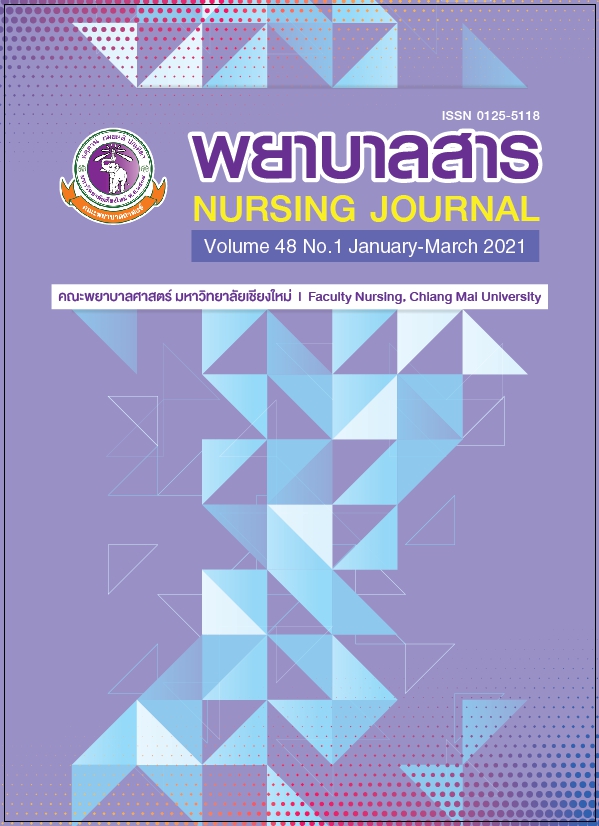The Nurses’ Role in Rational Drug Use in Hospital
Keywords:
Nurses' role, rational use of drugs, nursing processAbstract
The consideration for the reason or the necessity for drug usage is essential because of the unreasonable unwarranted use of drugs that may cause negative side-effects for the patient. This may lead to treatment failure or an adverse drug reaction, and may additionally affect a variety of physical abilities for the patient. This article aims to indicate the importance of reasonable drug usage and the role for registered nurses to review and apply the nursing process along with a rational drug usage regime in hospitals according to the interdependent role and apply this under the Nursing and Midwifery Act (No. 2), B.E. 2001 (2001) of Thailand Nursing and Midwifery Council.
Rational use of drugs in the hospital is important considering that using quality and effective drugs appropriately and safely provides clinical benefits greater than the risks to the patients while receiving treatment in the hospital. Therefore, the interdependent role of registered nurses in providing drugs by applying the nursing process consist of; the patient’s health condition assessment, medicine pharmacological diagnosis, medicine providing plan according to 10 principles, processing as per the plan, and following up the treatment assessment, including monitoring of side effects after taking medicine. For this reason the nursing process is an effective tool for the nursing process, and provides the maximum benefit and safety for their patients
References
Almazroo, O. A., Miah, M. K., & Venkataramanan, R. (2017). Drug metabolism in the liver. Clinics in Liver Disease, 21(1), 1-20.
Ased, S., Wells, J., Morrow, L. E., & Malesker M. A. (2018). Clinically significant food-drug interactions. The Consultant Pharmacist, 33(11), 649-657.
Chillistone, S., & Hardman, J. G. (2017). Factors affecting drug absorption and distribution. Anaesthesia and Intensive Care Medicine, 18(7), 335-9.
Health Product Vigilance Center. (2018). Spontaneous reports of adverse drug reactions A.D. 2017. Bangkok: Aksorn Graphic and Design Publishing House. (In Thai)
Ivanyuk, A., Livio, F., Biollaz, J., & Buclin, T. (2017). Renal drug transporters and drug interactions. Clinical Pharmacokinetics, 56(8), 825-92.
Katzung, B. G., & Trevor, A. J. (2018). Basic and clinical pharmacology (14th ed.). New York: McGraw-Hill Education.
Koziolek, M., Alcaro, S., Augustijns, P., Basit, A. W., Grimm, M., Hens, B., … Corsetti, M. (2019). The mechanisms of pharmacokinetic food-drug interactions - A perspective from the UNGAP group. European Journal of Pharmaceutical Sciences, 134, 31-59.
Lamchang, S., Suklerttrakul, T., & Lamchang, P. (2020). Development of pediatric medication administration multimedia for nursing students. Nursing Journal, 46(1), 114-125. (In Thai)
Lilley, L. L., Collins, S. R., Snyder, J. S. (2019). Pharmacology and the nursing process E-Book (9th ed.). Canada: Elsevier Health Sciences.
Medicines Regulation Division. (2013). Food and drug administration ministry of public health. National list of essential medicines A.D. 2013. Bangkok: The Agricultural Cooperative Federation of Thailand. Limited. (In Thai)
Mousavi, S., & Ghanbari, G. (2017). Potential drug-drug interactions among hospitalized patients in a developing country. Caspian Journal of Internal Medicine, 8(4), 282-288.
Nutescu, E., Chuatrisorn, I., & Hellenbart, E. (2011). Drug and dietary interactions of warfarin and novel oral anticoagulants: An update. Journal of Thrombosis and Thrombolysis, 31(3), 326-343.
Potter, P. A., Perry, A. G., Stockert, P. A., & Hall, A. M. (2020). Fundamentals of nursing-E-Book (10th ed.). St. Louis, Missouri: Elsevier.
Sangsonggrit, N., Pinyopasakul, W., Kusuma Na Ayuthya, S., Sriprasong, S., & Nilanont, Y. (2014). Predictors of medication adherence in ischemic stroke patients. Nursing Journal, 41(2), 61-71. (In Thai)
Spencer, S., Ipema, H., Hartke, P., Krueger, C., Rodriguez, R., Gross, A. E., … Gabay, M. (2018). Intravenous push administration of antibiotics: Literature and considerations. Hospital Pharmacy, 53(3), 157-69.
Taylor, C., Lynn, P., & Bartlett, J. (2019). Fundamentals of Nursing: The art and science person-centered care (9th ed.). Philadelphia: Wolters Kluwer.
Thailand Nursing and Midwifery Council. (2001). Nursing and midwifery standard A.D. 2001. Retrieved April 6, 2020, from: https://www.tnmc.or.th/images/userfiles/ files/A666.pdf. (In Thai)
Tiotiu, A., Novakova, P., Kowal, K., Emelyanov, A., Chong-Neto, H., Novakova, S., … Labor, M. (2019). Beta-blockers in asthma: Myth and reality. Expert Review of Respiratory Medicine, 13(9), 815-22.
Wooten, J. M. (2012). Pharmacotherapy considerations in elderly adults. Southern Medical Journal, 105(8), 437-45.
World Health Organization. (1987). The rational use of drugs: Report of the conference of experts, Nairobi, 25-29 November 1985 (pp. 138-148). Geneva: Albany: World Health Organization.
Downloads
Published
How to Cite
Issue
Section
License
บทความที่ได้รับการตีพิมพ์เป็นลิขสิทธิ์ของวารสารพยาบาลสาร
ข้อความที่ปรากฏในบทความแต่ละเรื่องในวารสารวิชาการเล่มนี้เป็นความคิดเห็นส่วนตัวของผู้เขียนแต่ละท่านไม่เกี่ยวข้องกับมหาวิทยาลัยเชียงใหม่ และคณาจารย์ท่านอื่นๆในมหาวิทยาลัยฯ แต่อย่างใด ความรับผิดชอบองค์ประกอบทั้งหมดของบทความแต่ละเรื่องเป็นของผู้เขียนแต่ละท่าน หากมีความผิดพลาดใด ๆ ผู้เขียนแต่ละท่านจะรับผิดชอบบทความของตนเองแต่ผู้เดียว






